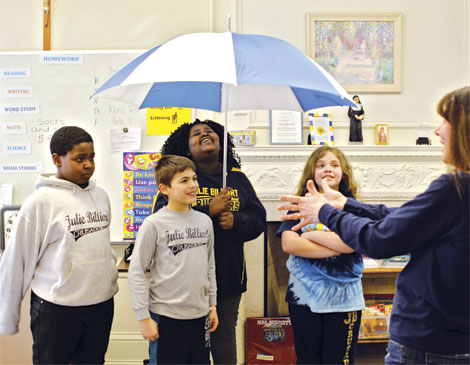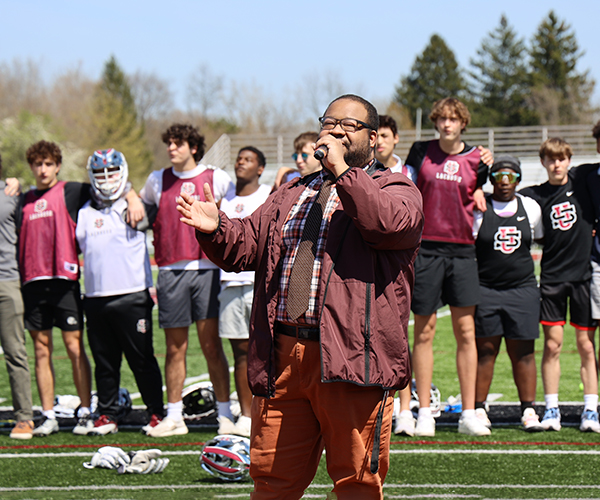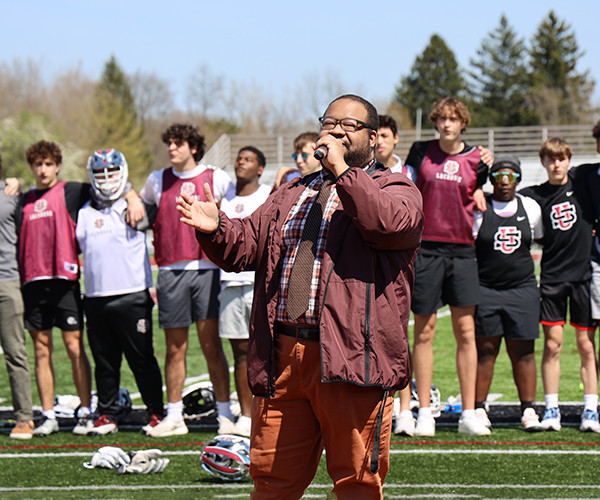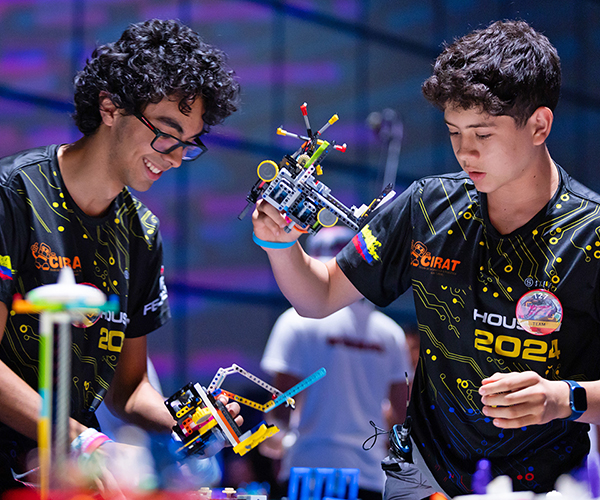It's what nature-inspired transcendentalist writers such as Henry David Thoreau and Margaret Fuller would have wanted, says Andrews Osborne English department chair Marina Vladova.
To learn about the literary movement, each student adopts an outdoors practice such as bird-watching or creek surveying and jots down thoughts in a journal while engaging in the activity.
"Reflection comes out of experience," says Vladova. "It wouldn't be fair to have them just learn about it and take a test."
Increasingly, individual teachers and entire schools are developing more hands-on and creative ways to bring academic concepts to life, whether it's science, music, math, history or English.
Influenced by Alexandra Horowitz's On Looking: Eleven Walks with Expert Eyes, Vladova requires students to take along a specialist, such as a groundskeeper, chemist or art professor for three of the excursions. The added perspective encourages students to express themselves in new ways — or as Emerson once wrote, "Always the seer is a sayer."
"They will brighten a student's attention to details they may have never noticed," says Vladova.
The final entry takes place at an annual field trip to Thoreau's former dwelling in the 335-acre Walden Pond State Reservation in Concord, Massachusetts.
"They have this sense of place," Vladova says. "It takes this experiential practice to understand that they're learning about a state of mind."
The environment can be an abundant resource ripe with lessons. As Lake Kilroy freezes on the University School campus in Chagrin Falls, it transforms into a laboratory.
When the ice is thick enough, sophomore chemistry students venture out to collect gas through water displacement. Circular holes are cut through the ice, and jars are overturned in the water. By pushing metal poles into the methane-producing leaves and other decaying buildup collected at the bottom of the lake, gas bubbles to the surface and pushes the water out of the jar.
When they trek back to the classroom, it looks as though they've captured little more than air. Students place a funnel over the jar and light the gas at the top, creating a bright blue flame.
Students learn how to quantify the amount of gas captured and released, but the experiment also leads to larger discussions on commodifying natural gas.
"If we only do something on paper, the kids will remember it for as long as they have to," says instructor Karen Axelrod. "This makes things real in a way that sticks."
She hopes it changes the way her students look at their surroundings as well — especially the lake. "They look at it as not just a pretty place," she says, "but a resource they can learn from."
The inspiration of systems and patterns found in nature to solve human challenges is the basis of Lake Ridge Academy's biomimicry course.
Juniors and seniors learn aeronautical concepts by studying wind turbine blades and testing their own models that mimic elements of a pelican wing, humpback whale fin and even a maple seed.
"Whereas most people grow up with nature being something to look at out of a window," says Lake Ridge science instructor Andy Wright, "they gain a new appreciation of nature as a teacher."
With the assistance of Lake Ridge art instructor Carolyn Ballou, students use computer-aided design software and a MakerBot Replicator 3-D printer to construct their blades out of polylactic acid. Then, they test their creations on a miniature wind turbine.
To offer another view, Wright's students tour the NASA Glenn Research Center with an engineer who works on aircraft turbine blades. They see firsthand how a blade modeled after a seal's whisker has cut down drag, and in turn fuel costs, by 30 percent or more.
"So many times students look at what they're doing and they don't see how it can connect to the real world," says Wright. "By going to NASA, they see not only does it matter, it can lead to major advancements."
Gilmour Academy uses computer-aided design and 3-D printing to learn geometry. What began as a calculus-level activity has become an intricate part of sophomore geometry curriculum. Students draft and print their own prisms, cones and spheres as a way to better visualize mathematics.
"We're not handing them a formula," says Gilmour instructor Mary Merkel. "They're developing their own objects to create their own understanding."
She sees other applications predicting increased integration of 3-D printing and basic CAD knowledge in more career paths.
"Some of these kids who think they're never going to be good at math are very interested in the manufacturing of an object that doesn't just live in an abstract world," she says. "They have to be sure they're making something that works in the real world."
At Laurel School, seventh- and eighth-graders enrolled in the engineering design lab learn the physics of sound through the National STEM Guitar Project, which helps with training and resources to add guitar building to a school's curriculum.
Students study subjects such as guitar geometry, electronic circuits, scale length, frequency and string tension, and use that knowledge to craft each piece of the guitar. Making everything work harmoniously — adjusting tension of the truss rod and the spacing of the frets, for example — requires much more than stage presence.
"The determination of the spacing is a complex physical problem," says Laurel instructor Ken Schopf. "To make a string vibrate at a frequency of A, for example, it all has to be in exactly the right place."
Students use CAD to design parts of the guitar and fabricate their components on laser cutters at Case Western Reserve University's Thinkbox makerspace. From the wood grain to the wiring, the design is completely in their hands.
"There's something empowering about watching these students blasting away with a sander on their guitar bodies," says Schopf.
At Julie Billiart School, intervention specialist Danielle Bennett uses music to make science concepts easier to recall. Bennett created a rap song for her fourth-graders about severe weather topics.
"All this information can be overwhelming," say Bennett. "But by putting it into song, it's a great way to help them remember these important concepts."
She knew her playful tune was starting to stick when students broke out in song. When recess was approaching but it looked like rain, they sang: "I want to go out and play but I'm not allowed / Mom saw a cumulonimbus cloud."
It's a testament to the power of music as a teaching tool that Bennett's former students still recall all the words years later.
On snowy days, Bennett often sees an older student in the hall and raps a line, "Cold air at the surface, moisture and lift." Without missing a beat, the student chimes back: "Will make that blizzard, do you get my drift?"
"Now, from the first day of school, students ask, 'When are we going to learn the weather rap?' " says Bennett. "This is the kind of excitement every teacher hopes to see."




